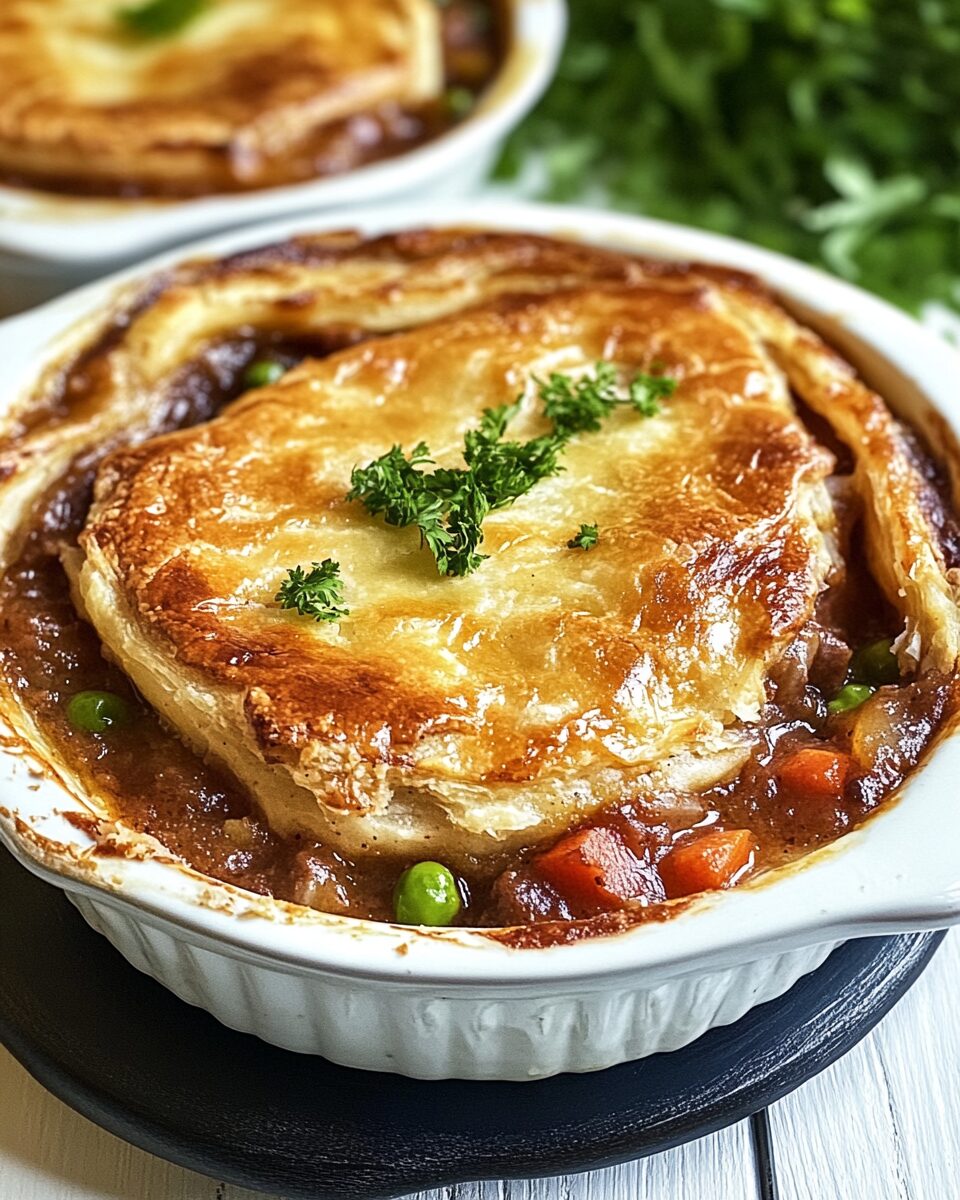This Traditional Irish Cottage Pie is the ultimate comfort food, featuring a rich and savory filling made with ground beef, vegetables, and flavorful herbs. The golden, flaky puff pastry crust adds a delightful crunch to every bite. It’s a cozy dish perfect for family dinners or special gatherings. Whether you’re celebrating St. Patrick’s Day or just craving a hearty, warming meal, this Cottage Pie is sure to satisfy. The combination of tender meat, perfectly seasoned veggies, and buttery pastry creates a deliciously satisfying dish that’s loved by all ages. Pair it with a side of greens or a fresh salad for a complete and memorable meal.
Full Recipe:
Ingredients:
- 1 tbsp olive oil
- 1 lb lean ground beef
- 1 package of mushrooms, sliced
- 2 cups finely chopped onion
- 2 carrots, diced small
- 3 tbsp flour
- 1/2 cup beef stock
- 1 tsp Worcestershire sauce
- 2 tbsp tomato paste
- 1 tsp Dijon mustard
- Salt and black pepper to taste
- 1 tsp fresh thyme leaves (or 1/2 tsp dried)
- 1 sheet puff pastry, thawed
- 1 egg, lightly whisked
Directions:
- Preheat the oven to 400°F (200°C).
- In a large skillet, heat olive oil over medium-high heat. Sauté the onions and carrots for 3-4 minutes until they begin to soften.
- Add the ground beef and mushrooms. Cook until the beef is browned, about 3 minutes.
- Sprinkle the flour over the meat mixture and toss to coat. Cook for another minute, stirring constantly.
- Stir in the tomato paste, beef stock, Worcestershire sauce, Dijon mustard, salt, pepper, and thyme. Mix well.
- Bring to a boil, then reduce heat to low. Cover and simmer for 10-12 minutes until the sauce thickens slightly.
- Meanwhile, roll out the thawed puff pastry to fit your baking dish.
- Transfer the meat filling to a baking dish. Cover with the puff pastry, trimming the edges as needed.
- Brush the pastry with the whisked egg.
- Place the dish on a parchment-lined baking sheet and bake for 25 minutes, or until the pastry is golden brown.
- Let it cool slightly before serving.
Prep Time: 20 minutes | Cooking Time: 40 minutes | Total Time: 1 hour
Kcal: 295 kcal per serving | Servings: 4
The History and Origins of Cottage Pie
Cottage Pie traces its roots back to the late 18th century in the United Kingdom and Ireland. The term “Cottage Pie” was first used in 1791 when potatoes became an affordable crop for the poor. It was a way to utilize leftover meat, particularly beef, and stretch it into a filling and satisfying meal by combining it with vegetables and topping it with mashed potatoes. The name “Cottage Pie” comes from the modest cottages where peasants and farmers lived, highlighting its origin as a humble, resourceful dish.
Interestingly, the concept of combining meat and vegetables under a topping is ancient, dating back to Roman times. However, the modern version of Cottage Pie gained popularity during the Industrial Revolution when potatoes became a staple food for working-class families. This practical and budget-friendly meal quickly spread across Ireland and the UK, becoming a beloved comfort food.
Cottage Pie vs. Shepherd’s Pie: What’s the Difference?
Many people confuse Cottage Pie with Shepherd’s Pie, but the distinction is quite simple: the type of meat used. Traditionally, Cottage Pie is made with ground beef, while Shepherd’s Pie is made with ground lamb. The reason for this difference is regional; lamb was more readily available in Ireland, while beef was more common in England.
Over time, the lines between the two dishes have blurred, with both versions becoming popular worldwide. In some regions, the terms are used interchangeably, but purists insist on maintaining the distinction. Regardless of the meat used, both dishes are topped with creamy mashed potatoes, though modern variations sometimes use puff pastry for a flaky, golden crust.
Cultural Significance and Popularity
Cottage Pie holds a special place in Irish and British culinary traditions. It represents comfort, family gatherings, and nostalgia. Often served during the colder months, it’s the perfect warming meal for cozy nights. In Ireland, it’s particularly popular on St. Patrick’s Day, symbolizing Irish heritage and tradition.
The dish’s versatility and adaptability have helped it remain popular through the centuries. It is a staple in pubs and households alike, appreciated for its simplicity and heartiness. Whether served at a family dinner or a festive holiday gathering, Cottage Pie brings people together and evokes a sense of home and comfort.
Regional Variations
While the traditional version uses ground beef and vegetables like onions, carrots, and peas, there are countless regional variations of Cottage Pie. In Ireland, some versions include stout beer for a richer, deeper flavor, while others use lamb to create a hybrid between Cottage Pie and Shepherd’s Pie.
In England, Worcestershire sauce and thyme are commonly added for a savory kick. Scottish versions might incorporate haggis or use oats as a thickener, paying homage to local ingredients. In Australia and New Zealand, Cottage Pie is often made with minced lamb or even kangaroo meat, showcasing local culinary traditions.
Across the Atlantic, American adaptations sometimes include corn or cheese, reflecting the influence of Shepherd’s Pie recipes brought by Irish immigrants. These variations demonstrate how Cottage Pie has evolved and been embraced by different cultures while retaining its essential character.
Tips for Enhancing Flavor
To make an exceptional Cottage Pie, consider these tips for enhancing the flavor:
- Choose Quality Meat: Using lean ground beef or even a mix of beef and pork adds depth and richness to the filling. For a more authentic Irish version, opt for lamb.
- Build Layers of Flavor: Sautéing onions, garlic, and vegetables before adding the meat creates a flavorful base. Deglazing the pan with a splash of red wine or stout can elevate the taste.
- Rich and Savory Gravy: Using beef stock, tomato paste, and Worcestershire sauce enhances the umami flavor. Allowing the filling to simmer and thicken intensifies the richness.
- Perfect Toppings: Traditional mashed potatoes provide a creamy, fluffy topping that contrasts beautifully with the savory filling. For added texture, rough up the surface with a fork before baking to create crispy peaks. Alternatively, using puff pastry adds a buttery, flaky crunch.
- Seasoning and Herbs: Fresh thyme, rosemary, or parsley complement the meat and vegetables. Adjusting salt and pepper to taste ensures the dish is well-seasoned.
Serving Suggestions
Cottage Pie is a complete meal on its own but pairs wonderfully with simple side dishes. Popular accompaniments include:
- Steamed Green Beans or Peas: These provide a fresh, vibrant contrast to the rich filling.
- Buttered Cabbage: A nod to traditional Irish sides, this adds a tender, buttery complement.
- Crusty Bread: Perfect for soaking up the delicious gravy.
- Side Salad: A crisp, refreshing salad balances the heartiness of the pie.
For drinks, Cottage Pie pairs well with a pint of Irish stout or a glass of red wine, enhancing the savory flavors.
Why Irish Cottage Pie Remains a Family Favorite
Cottage Pie endures as a beloved comfort food because of its simplicity, versatility, and heartwarming appeal. It’s a budget-friendly, one-dish meal that can be easily adapted to suit individual tastes and dietary needs. Whether made with ground beef, lamb, or even plant-based alternatives, it remains satisfying and flavorful.
This dish’s nostalgic value also contributes to its popularity. It evokes memories of family dinners, cozy evenings, and holiday gatherings. Passed down through generations, Cottage Pie holds sentimental significance, reminding people of home and tradition.
In today’s fast-paced world, Cottage Pie offers a comforting escape, bringing a sense of warmth and togetherness. Its timeless appeal and ability to evolve with changing tastes ensure that it will continue to be cherished for generations to come.
Conclusion:
Traditional Irish Cottage Pie is more than just a meal; it’s a piece of culinary history that carries the spirit of resourcefulness and comfort. From its humble origins in rural cottages to its status as a global comfort food favorite, Cottage Pie has endured the test of time. Its rich flavors, cultural significance, and adaptability make it a go-to dish for families worldwide.
Whether served at a casual family dinner or a festive celebration, Cottage Pie brings people together with its hearty goodness. Its timeless appeal lies in its ability to evolve while preserving its authentic essence. With its warm, comforting layers and rich history, Cottage Pie will continue to be a cherished dish that satisfies the soul and delights the palate.






